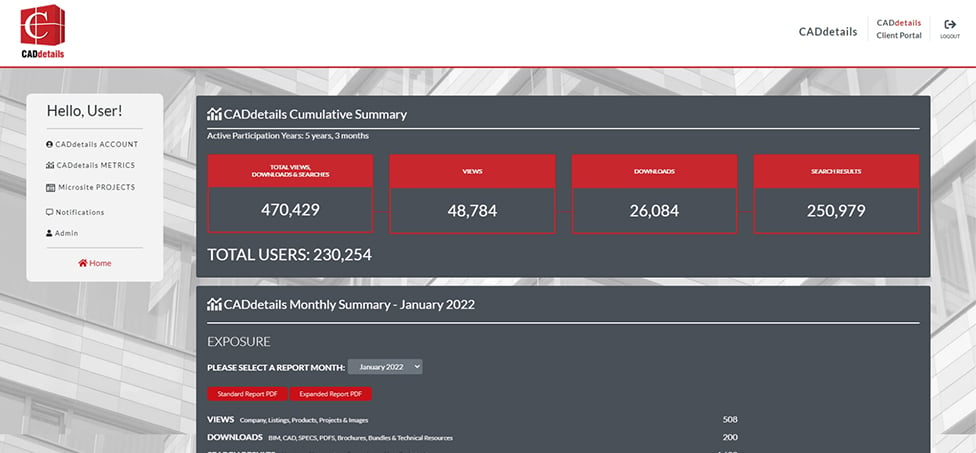Understanding your customer and how to best meet their needs is at the core of successful marketing. Marketers need to know where their customers are focusing their attention and what they visit a brand’s website. Data and analytics about customer behavior provide valuable insights to most marketers. Landscape and building product manufacturers are challenged by a selling cycle that can make valuable insight elusive. This article will discuss the potential of analytics, some of the challenges faced by marketers, and how building product manufacturers can leverage analytics to help get their products specified in construction projects.
Customer Experience
Companies want insight into a customer’s experience with their brand. That experience is happening increasingly online. The pandemic drove shoppers online and that has resulted in a permanent shift that sees customers interacting with brands more and more through digital channels. In response, companies are spending more on technology including artificial intelligence, data, and analytics.
The online retail customer journey is likely to take place over multiple channels. Ads may be seen in online videos, email marketing, radio ads, and on social media. The advertising message might be reinforced in blogs and articles, by word of mouth, or through an organic search. The information from all of these channels can be harnessed and used to better inform a company’s decision-making process and optimize its messaging.
For a building product manufacturer, the client journey is different. They need to reach architects and designers while they are planning projects. The journey will be influenced by professional events and spaces, firm experience, project owner preference, and the availability of product information and design files. The data and tools used by marketers in construction should reflect the realities of the industry, which by the very nature of construction, are distinct from other industries.
Leverage Data to Provide Better Outcomes
Marketing analytics include the data and tools that help marketers monitor their marketing efforts. There are many insights to be gained from robust data. Companies can improve their operational efficiency and customer satisfaction by leveraging their data. Website data can be used to personalize the user experience, identify trends, measure the ROI from marketing activities, and optimize marketing approaches. Specific product information can be valuable when properly leveraged. Data can be used to optimize the upsell and cross-sell of complimenting products. Analytics can be used to guide product development as data can be analyzed to determine the most and least liked products. Knowing how products perform allows marketers to be responsive and agile. The sharing of data within a company empowers all teams and prevents data silos.
Marketers can use analytics to know exactly how all the various moving parts of a campaign drive sales, and how adjustments to the various parts impact sales. A good analytics program gives marketers the ability to target the right audience in the right place, even when the target audience is spread across multiple channels. Analytics allow for experimentation such as A/B testing wherein website visitors are sent to two distinct versions of a website, or receive different versions of an email campaign. Marketers can use analytics to determine how customer behavior was influenced by the different versions. Predictive analytics uses artificial intelligence and historical data to make predictions and improve messaging.
Analytics and Getting Building Products Specified
There are fewer channels relevant for advertising directly to architects. A building product manufacturer would not typically advertise products that are to be specified by professionals on billboards, TV ads, or in general lifestyle magazines. While conventional online shopping can provide retailers with immediate information, it is much more complicated when discussing specified products. Often in construction, the purchase of a product happens long after specifying decisions are made. Products may be specified in a project during the design phase, but the purchase happens during construction. Selection may happen by the design team, but the contractor makes the purchase later. The time between these events can be years. Connecting these dots is an ongoing challenge as tracking data can be elusive.
Traditional and conventional marketing channels do not serve the professional design community well. Building product manufacturers need to use different channels and platforms to reach architects and designers looking for products to specify. CADdetails offers analytics that provides valuable insights with an in-depth data tracking tool.
CADdetails analytics allow landscape and building product manufacturers to know which of their products are getting the most traction and interest. They can also find out which design file types are accessed most frequently. This information can be leveraged to decide what products to promote to professional designers and architects, as well as what types of product information to provide. The CADdetails Microsite provides manufacturers with stand-alone product information they can share anywhere online. The Microsite includes enhanced analytics that allows manufacturers to capture valuable leads.

CADdetails has specialized in connecting product manufacturers with actively specifying architects and designers since 1997. If you are a landscape or building product manufacturer in need of reaching architects and being empowered by analytics, talk to us today!

